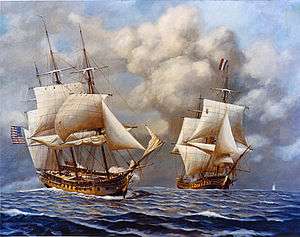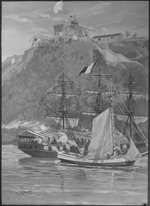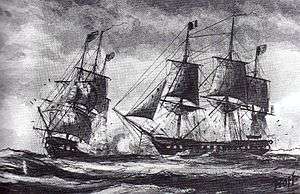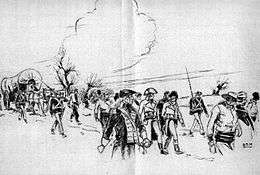Quasi-War
| Quasi War | |||||||
|---|---|---|---|---|---|---|---|
| Part of the French Revolutionary Wars and the War of the Second Coalition | |||||||
  From top to bottom: USS Constellation vs L'Insurgente; U.S. Marines from the USS Constitution boarding and capturing French privateer Sandwich | |||||||
| |||||||
| Belligerents | |||||||
|
Co-belligerent: |
| ||||||
| Commanders and leaders | |||||||
|
|
| ||||||
| Strength | |||||||
|
A fleet of 54 including: 18 Frigates 4 Sloops 2 Brigs 3 Schooners 5,700 sailors and Marines 365 privateers |
Unknown fleet size Unknown number of sailors and marines | ||||||
| Casualties and losses | |||||||
|
American:
After U.S. military involvement:
British:
|
French:
| ||||||
The Quasi-War (French: Quasi-guerre) was an undeclared war fought almost entirely at sea between the United States and France from 1798 to 1800. After the French crown was overturned during the French Revolutionary Wars, the United States refused to continue repaying its large debt to France, which had supported it during its own revolution. It claimed that the debt had been owed to a previous regime. Outraged, France authorized privateers to conduct attacks on U.S. shipping, seizing numerous merchant ships, and ultimately the U.S. retaliated.
The war was called "quasi" because it was undeclared. It involved two years of hostilities at sea, in which both navies and privateers attacked the other's shipping in the West Indies. The unexpected fighting ability of the newly re-established U.S. Navy, which concentrated on attacking the French West Indian trade, together with the growing weaknesses and final overthrow of the ruling Directory in France, led Foreign Minister Charles Maurice de Talleyrand-Périgord (known as Talleyrand) to reopen negotiations with the US. At the same time, President John Adams feuded with Hamilton over control of the Adams administration. Adams took sudden and unexpected action, rejecting the anti-French hawks in his own party and offering peace to France. In 1800 he sent William Vans Murray to France to negotiate peace; the Federalists cried betrayal. Hostilities ended with the signing of the Convention of 1800.[4]
Background
The Kingdom of France, a crucial ally of the United States in the American Revolutionary War after early 1776, had loaned the U.S. large amounts of money, and in 1778 it signed a treaty of alliance against Great Britain. However, Louis XVI of France was overthrown in 1792 during the French Revolution, and the French monarchy was abolished.
In 1794 the U.S. government reached an agreement with Great Britain in the Jay Treaty, which was ratified the following year. It resolved several points of contention between the United States and Britain that had lingered since the end of the American Revolution. The treaty encouraged bilateral trade, and enabled expanded trade between the United States and Britain, stimulating the American economy. From 1794 to 1801, the value of American exports nearly tripled, from $33 million USD to $94 million USD.[5] But the Jeffersonian Democrat Republicans, who were pro-France, always denigrated the Jay Treaty.[6][5]
The United States declared neutrality in the conflict between Great Britain and revolutionary France, and U.S. legislation was being passed for a trade deal with Great Britain. When the U.S. refused to continue repaying its debt, saying that the debt was owed to the previous government, not to the French First Republic, French outrage led to a series of responses. First, France authorized privateers to seize U.S. ships trading with Great Britain, and taking them back to port as prizes to be sold. Next, the French government refused to receive Charles Cotesworth Pinckney, the new U.S. Minister, when he arrived in Paris in December 1796, severing diplomatic relations.[5] In President John Adams's annual message to Congress at the close of 1797, he reported on France's refusal to negotiate a settlement and spoke of the need "to place our country in a suitable posture of defense."[7] In April 1798, President Adams informed Congress of the "XYZ Affair", in which French agents demanded a large bribe before engaging in substantive negotiations with United States diplomats.
Meanwhile, French privateers inflicted substantial losses on U.S. shipping. On 21 February 1797, Secretary of State Timothy Pickering told Congress that during the previous eleven months, France had seized 316 U.S. merchant ships. French marauders cruised the length of the Atlantic seaboard virtually unopposed. The United States government had nothing to combat them, as it had abolished the navy at the end of the Revolutionary War and its last warship sold in 1785. The United States had only a flotilla of small revenue cutters and a few neglected coastal forts.[1]
Increased depredations by French privateers led to the government in 1798 to establish the Department of Navy and the U.S. Marine Corps to defend the expanding U.S. merchant fleet. Benjamin Stoddert was appointed as Secretary of Navy.[1] Congress authorized the president to acquire, arm, and man not more than twelve ships of up to twenty-two guns each. Several merchantmen were immediately purchased and refitted as ships of war,[8] and construction of the frigate Congress resumed.
Congress rescinded the treaties with France on 7 July 1798. That date is now considered the beginning of the Quasi-War. Two days later Congress passed authorization for the US to attack French warships in U.S. waters. On 16 July Congress appropriated funds "to build and equip the three remaining frigates begun under the Act of 1794": Congress, launched at Portsmouth, New Hampshire, on 15 August 1799; Chesapeake, at Gosport Shipyard (now Norfolk Naval Shipyard), Virginia, on 2 December 1799; and President, at New York, New York, on 10 April 1800.[1]
Naval engagements
To make the most effective use of his limited resources, Secretary Stoddert established a policy that US forces would be concentrated on attacks against French forces in the Caribbean, where France still had colonies. At times he had to concede to merchant ships requests for escorts for defense.[1]
The U.S. Navy operated with a battle fleet of about twenty-five vessels, which patrolled the southern coast of the United States and throughout the Caribbean, hunting down French privateers. Captain Thomas Truxtun's insistence on the highest standards of crew training paid dividends when the frigate Constellation captured the French Navy's frigate L'Insurgente and severely damaged the frigate La Vengeance. French privateers generally resisted, as did La Croyable, which was captured on 7 July 1798, by Delaware outside Egg Harbor, New Jersey.[9]
Enterprise captured eight privateers and freed eleven U.S. merchant ships from captivity, while Experiment captured the French privateers Deux Amis and Diane. Numerous U.S. merchantmen were liberated by the Experiment. Boston forced Le Berceau into submission. Silas Talbot engineered an expedition to Puerto Plata harbor in Hispaniola. On 11 May 1800, sailors and marines from Constitution under Lieutenant Isaac Hull captured the French privateer Sandwich in the harbor and spiked the guns of the fort.
The U.S. Navy lost only one ship to the French, Retaliation. She was the captured privateer La Croyable, recently purchased by the U.S. Navy. Retaliation departed Norfolk on 28 October 1798, with Montezuma and Norfolk, and cruised in the West Indies protecting U.S. commerce. On 20 November 1798, the French frigates L’Insurgente and Volontaire overtook the Retaliation while her consorts were away; they forced commanding officer Lieutenant William Bainbridge to surrender the out-gunned schooner. The Montezuma and Norfolk escaped after Bainbridge convinced the senior French commander that those U.S. warships were too powerful for his frigates, and he should abandon the chase. The French renamed Retaliation as the Magicienne, but on 28 June Merrimack fired a broadside and forced her to haul down her colors, and took the former privateer back into US control.
Revenue cutters in the service of the U.S. Revenue-Marine (the predecessor to the U.S. Coast Guard), also took part in the conflict. The cutter USRC Pickering, commanded by Edward Preble, made two cruises to the West Indies and captured ten prizes. Preble turned command of the Pickering over to Benjamin Hillar, who captured the much larger and more heavily armed French privateer l'Egypte Conquise after a nine-hour battle. In September 1800, Hillar, the Pickering, and her entire crew were lost at sea in a storm.
Preble next commanded the frigate Essex, which he sailed around Cape Horn into the Pacific to protect U.S. merchantmen in the East Indies. He recaptured several U.S. ships that had been seized by French privateers.[10][11][12]
U.S. naval losses may have been light, but the French had successfully seized many U.S. merchant ships by the war's end in 1800 — more than 2,000, according to one source.[13][5]
Although they were fighting the same enemy, the Royal Navy and the United States Navy did not cooperate operationally or share operational plans. There were no mutual understandings about deployment between their forces. However, the British sold naval stores and munitions to the U.S. government, and the two navies shared a signal system so they could recognise the other's warships at sea and allowed their merchantmen to join each other's convoys for safety.
 The fight between the USS Constellation and the L'Insurgente (William Bainbridge Hoff)
The fight between the USS Constellation and the L'Insurgente (William Bainbridge Hoff) A 20th-century illustration depicting United States Marines escorting French prisoners
A 20th-century illustration depicting United States Marines escorting French prisoners
Conclusion of hostilities
By late 1800, the United States Navy and the Royal Navy, combined with a more conciliatory diplomatic stance by the government of First Consul Napoleon Bonaparte, had reduced the activity of the French privateers and warships. The Convention of 1800, signed on 30 September, ended the Quasi-War. It affirmed the rights of Americans as neutrals upon the sea and abrogated the alliance with France of 1778. However, it failed to provide compensation for the $20,000,000 "French Spoliation Claims" of the United States. The agreement between the two nations implicitly ensured that the United States would remain neutral toward France in the wars of Napoleon and ended the "entangling" French alliance.[14] This alliance had been viable only between 1778 and 1783.[15][16]
See also
References
- ↑ "Military history – The Quasi War". About.com.
- ↑ America’s First Limited War, Lieutenant Colonel Gregory E. Fehlings, U.S. Army Reserve
- ↑ E. Wilson Lyon, "The Franco-American Convention of 1800," Journal of Modern History 12.3 (1940): 305–333. online
- 1 2 3 4 Donald R. Hickey, "The Quasi-War: America's First Limited War, 1798-1801", The Northern Mariner/le marin du nord, XVIII Nos. 3–4, (July–October 2008), pp. 67–77
- ↑ Jerald A. Combs, The Jay Treaty: Political Battleground of the Founding Fathers (1970).
- ↑ First State of the Nation Address by President John Adams Philadelphia, PA, 22 November 1797
- ↑ Greg H., Williams (2009). McFarland, ed. The French Assault on American Shipping, 1793–1813: A History and Comprehensive Record of Merchant Marine Losses. p. 25. ISBN 978-07-86-45407-5.
- ↑ Mooney, James L., ed. (November 1983). Dictionary of American Naval Fighting Ships. 6. Defense Dept., Navy, Naval History Division. p. 84. ISBN 978-0-16-002030-8. Retrieved 27 June 2011.
- ↑ The United States Coast Guard The Coast Guard at War
- ↑ USRCS Lost at Sea
- ↑ Love 1992, p. 68
- ↑ Lieutenant Colonel Gregory E. Fehlings, "America’s First Limited War", Naval War College Review, Volume 53, Number 3, Summer 2018
- ↑ E. Wilson Lyon, "The Franco-American Convention of 1800." Journal of Modern History 12.3 (1940): 305–333. online
- ↑ Alexander DeConde, The Quasi-War: The Politics and Diplomacy of the Undeclared War with France, 1797–1801 (1966).
- ↑ Paul A. Varg, Foreign policies of the founding fathers (1963), pp 117–44 online free, Internet Archive
Further reading
- Allen, Gardner W. (1909). Our Naval War with France. New York: Houghton Mifflin Publishers.
- Bowman, Albert Hall. The struggle for neutrality: Franco-American diplomacy during the Federalist era (1974), online free
- Daughan, George C. (2008). If By Sea: The Forging of the American Navy – From the Revolution to the War of 1812. Philadelphia: Basic Books. ISBN 978-0-465-01607-5.
- De Conde, Alexander (1966). The quasi-war: the politics and diplomacy of the undeclared war with France 1797–1801. New York: Scribner's.
- Kingston, Christopher. "Marine Insurance in Philadelphia During the Quasi-War with France, 1795–1801." Journal of Economic History (2011) 71#01 pp. 162–184
- Leiner, Frederick C. (1999). Millions for Defense: The Subscription Warships of 1798. Annapolis: US Naval Institute Press. ISBN 978-1-55750-508-8.
- Love, Robert (1992). History of the U.S. Navy Volume One 1775–1941. Harrisburg PA: Stackpole Books. ISBN 978-0-8117-1862-2.
- Nash, Howard Pervear. The forgotten wars: the role of the US Navy in the quasi war with France and the Barbary Wars 1798–1805 (AS Barnes, 1968)
- Palmer, Michael A. Stoddert's war: Naval operations during the quasi-war with France, 1798–1801. Naval Institute Press, 1999
- Toll, Ian W. (2006). Six Frigates: The Epic History of the Founding of The U.S. Navy. New York: W.W. Norton. ISBN 978-0-393-05847-5.
- Unger, Harlow (2005). The French War Against America: How a Trusted Ally Betrayed Washington and the Founding Fathers. Hoboken NJ: John Wiley & Sons, Inc. ISBN 978-0-471-65113-0.
- Williams, Greg H. (2009). The French Assault on American Shipping, 1793–1813: A History and Comprehensive Record of Merchant Marine Losses. McFarland. ISBN 9780786454075.
External links
- Selected Bibliography of The Quasi War with France compiled by the United States Army Center of Military History
- U.S. Department of State The XYZ Affair and the Quasi-War with France, 1798–1800
- U.S. treaties and federal legal documents re "Quasi War with France 1791–1800", compiled by the Lillian Goldman Law Library of Yale Law School